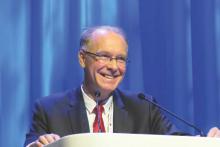VIENNA – Elderly patients over age 75 with newly diagnosed multiple myeloma derive the same survival benefits from continuous lenalidomide and low-dose dexamethasone as those under 75, according to a new analysis of the pivotal phase III FIRST trial.
In those older than 75 years, continuous lenalidomide (Revlimid) and low-dose dexamethasone demonstrated a 14-month overall survival advantage (hazard ratio, 0.72; 95% confidence interval, 0.54-0.96) and 20% reduction in the risk of progression or death (HR, 0.80; 95% CI, 0.62-1.03) compared with melphalan (Alkeran) plus prednisone and thalidomide (MPT).
“With dose adjustment and monitoring, this continuous len-dex arm was effective and safe, even in very elderly and frail patients. This [trial] establishes this regimen as a global standard of care for transplant-ineligible patients,” Dr. Thierry Facon said at the annual congress of the European Hematology Association.
FIRST is the largest randomized trial in this setting and allocated 1,623 patients to lenalidomide plus low-dose dexamethasone in 28-day cycles until disease progression (Rd continuous) or 18 cycles of the same regimen for 72 weeks (Rd 18) or 12 cycles of MPT for 72 weeks.
In an interim analysis published in the New England Journal of Medicine (2014 [doi:10.1056/nejmoa1402551]) treatment with Rd continuous reduced the risk of progression or death by 28% and the risk of death by 22%, compared with MPT, a standard therapy for transplant-ineligible patients.
The new analysis is important because it is the first to examine the impact of age on the efficacy and safety of Rd continuous. Multiple myeloma is a disease of the elderly, with roughly one-third of patients diagnosed at more than 75 years, according to Dr. Facon of University Hospital Huriez, Lille, France.
Overall, 567 patients were older than 75 years (median 79 years) and 1,056 were 75 years or less (median 70 years). Starting doses for the very elderly group were reduced from 40 mg to 20 mg for dexamethasone; from 200 mg to 100 mg for thalidomide; and from 0.25 mg/kg to 0.20 mg/kg for melphalan. In patients with low blood count or impaired renal function, melphalan dose was reduced from 0.125 kg/mg to 0.10 mg/kg. All patients received thromboprophylaxis.
Median progression-free survival (PFS) in the 75-year and younger group was 28.1 months with Rd continuous, 21.6 months with Rd 18, and 22.4 months with MPT (Rd continuous vs. MPT: HR, 0.64; 95% CI, 0.53-0.77). The 4-year PFS rates were 37%, 15%, and 13%, Dr. Facon said.
In the very elderly group, median PFS reached 20.3 months, 19.4 months, and 19.8 months (HR, 0.80, also noted above), with 4-year PFS rates of 26%, 10%, and 11%.
“This is something quite important, illustrating the benefit of continuous therapy in terms of PFS,” he said.
Of note, median PFS in the interim analysis was similar at 25.5 months for Rd continuous, 20.7 months for Rd 18, and 21.2 months for MPT.
In the new analysis, overall survival in the 75 years and younger group was 60.9 months with Rd continuous, 60.6 months with Rd 18, and 55.3 months with MPT (Rd continuous vs. MPT: HR, 0.76, 95% CI, 0.60-0.96). The 4-year overall survival (OS) rates were 64%, 61%, and 57%.
Among the very elderly, median OS was 52.3 months with Rd continuous, 45.7 with Rd 18, and 37.8 months with MPT (HR, 0.72, also noted above), with 4-year OS rates of 52%, 48%, and 39%.
Duration of response was improved with Rd continuous treatment, irrespective of age, Dr. Facon said. The median duration for Rd continuous was 37 months in those aged 75 years and younger and 27 months in the very elderly, compared with 21-22 months for all other treatments.
Dose reductions due to adverse events were less common in those aged 75 years and under for Rd continuous than for MPT (37% vs. 52%), as were treatment discontinuations (21% vs. 26%). More very elderly patients required dose reductions for Rd continuous than MPT (44% vs. 36%), but fewer went on to discontinue Rd continuous (26% vs 29%), he said.
Rates of grade 3/4 neutropenia, the most common hematologic adverse event occurring in at least 5% of patients, were lower with Rd continuous and Rd 18 than with MPT in those aged 75 years and younger (28% vs. 25% vs. 47%) and in the very elderly (29% vs. 29% vs. 40%).
There is possibly a difference in cardiac events, which moved from 6% with MPT to 12% with Rd continuous in patients aged 75 years and younger and from 13% with MPT to 12% with Rd continuous in the very elderly, “but otherwise the results were quite similar, especially for neurologic toxicity and thromboembolic events,” he said.


